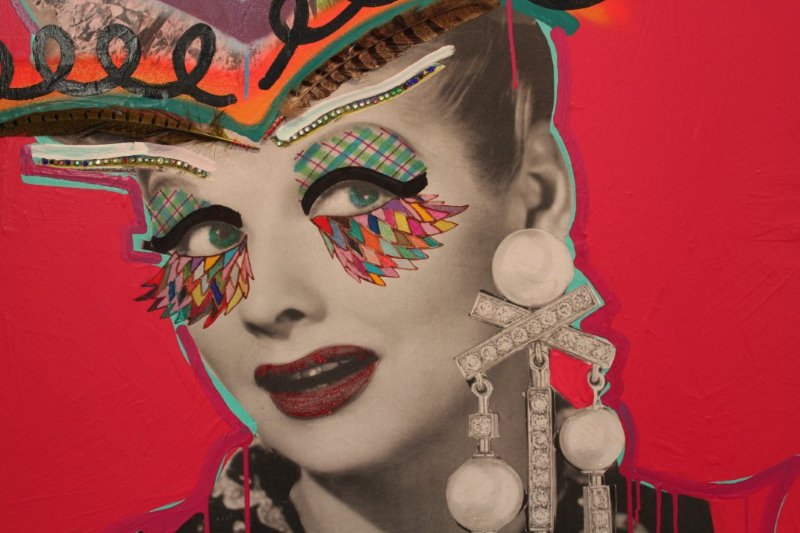
Tilt-Shift at the Luis De Jesus Los Angeles gallery is an intriguing show, exploring queer bodies and space. It's an eclectic exhibit with many voices, deliberating on homosexuality that isn't based on overt sexuality (no images of erect penises in sight!). What is offered is an array of images ranging from the austere to the fabulous.
In its press material, Tilt-shift is described as being comprised of "artists and artworks that resist the boundaries presented by in-your-face sexuality in favor of a broad range of ideas concerning the politics and aesthetics of marginalized bodies, cultures and identities.
In other words, as much as sex is a part of gay life, it's only one part of it. Queers have a lot of other things to say, and this show is providing a platform.
Curator Darin Klein shared some thoughts on queer art and its direction.
Why is queer art important today?
Queers gravitate towards geographic locations where like-minded people congregate. Although technological connectivity, spirituality and personal fortitude may make it possible for many different kinds of people to live satisfying lives outside of these spaces, queers take a political approach to constructing communities regardless of where they might land on a map.
There are 15 individual artists in the exhibition, and each of them has their own story to tell. One of the reasons I brought this group of artists together is that they each bring a different perspective to the overall dialogue of what has been accomplished before us and what still needs to be done in terms of acceptance, visibility and basic human rights. Queer art today is important for the same reason that it has always been important. As I wrote in my introductory essay for the exhibition, queer art proposes pragmatic solutions to, fantastic alternatives for, or straightforward documentation of the world as we experience it.
You don't choose to be gay. Gayness has nothing to do with a belief system. Queerness is philosophical, deliberate. Queers make decisions about how we want to live our lives, rather than just accepting what we are given and what comes to us naturally. And that is what comes out in our art.
It's a very eclectic show: painting, video, collage. Why did you choose these particular pieces?
First I narrowed down a long list of fantastic queer artists that I know personally and who are living and working in L.A. Then I looked at their output and chose artists that were using disparate mediums so that the exhibition would reflect the broad range of work being made by queer artists here in L.A.
All of the work in the exhibition was made within in the last five years. Much of the work was made specifically for this exhibition. It's a culmination and reconfiguration of the ideas of our forbears -- concepts, techniques and aesthetics that have been explored previously by queer artists have informed and guided the path to the artworks on view here.
How has the queer aesthetic changed in this new century?
Once the list of participating artists was finalized, it became apparent that queerness in the context of this exhibition is only partially about proclaiming and politicizing sexual orientation. The artwork in the exhibition tends to lean away from in-your-face sexual aesthetics. The main point has already been stated in the concept of the exhibition. We are partially defined by who we have sex with, but we are made complete by the many other facets of our individual selves.
Although there are still extremely important issues that were brought to the fore by the ACT UP movement and queer art at the end of the last century, I feel that we have now moved beyond the aesthetics of "We're here, we're queer, get used to it!"
Where do you think queer art and queer artists are heading?
Marginalized bodies are bodies that do not fall within societal expectations physically. Transgendered and intersexed bodies are marginalized. "Feminine" male bodies and "masculine" female bodies are marginalized. Bodies are marginalized due to certain levels of ability, states of health, age, size or color. It means that you are regarded as less valuable than others based on simple facts that you may or may not have control over. It means that being different is often seen as being bad, and that you may be pushed to the margins or excluded from rights that others take for granted. I believe queer art is headed toward a place that challenges and negates marginalization to the extent that it negatively affects individuals.
We are writing new chapters in history -- art history specifically -- that speak of our personal experiences. We draw pictures, choreograph dances, and take photographs that make up realities in which we can live comfortably. We're taking control back from anyone who said, "You can't live like this, you can't have these politics or think these thoughts." We are doing this oftentimes by building new worlds from scratch.

Tilt-Shift closes February 25.
Luis De Jesus Los Angeles
2685 S La Cienega Boulevard
Los Angeles, CA 90034
310.838.6000
www.luisdejesus.com
(Photos by Noel Alumit)
?
Follow Noel Alumit on Twitter: www.twitter.com/noelalumit
Source: http://www.huffingtonpost.com/noel-alumit/queer-art_b_1283105.html
don lapre aladdin weird al yankovic bling ring bling ring melissa mccarthy green river killer
No comments:
Post a Comment
Note: Only a member of this blog may post a comment.